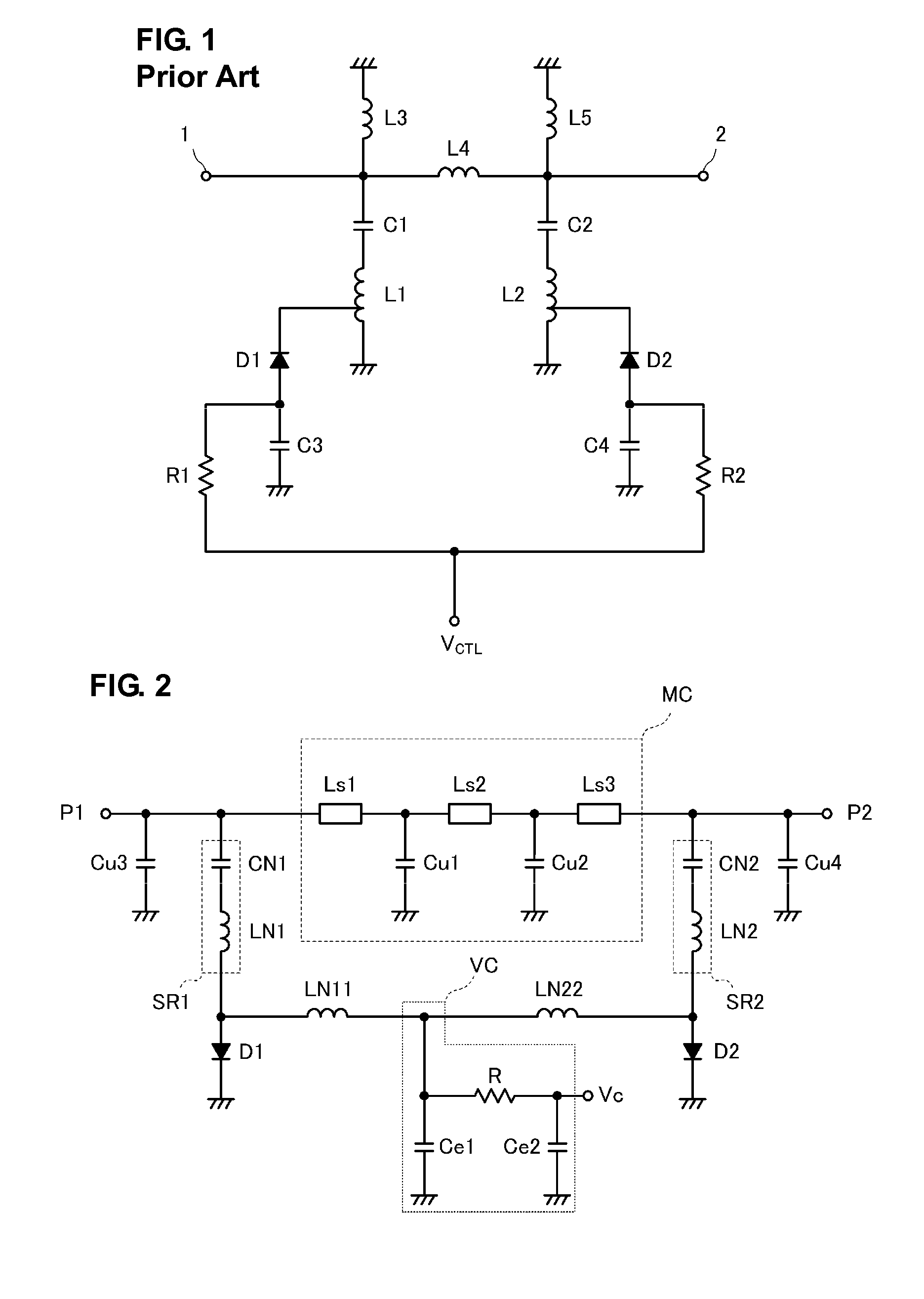Variable-frequency band-elimination filter
a filter and variable frequency band technology, applied in filters, multiple-port networks, electrical devices, etc., can solve the problems of deterioration of filter characteristics of variable frequency band filters, increased size of transmission/receiving modules, complex system configuration, etc., and achieve excellent filter characteristics and simple configuration.
- Summary
- Abstract
- Description
- Claims
- Application Information
AI Technical Summary
Benefits of technology
Problems solved by technology
Method used
Image
Examples
first preferred embodiment
[0031]A variable-frequency band-elimination filter according to the first preferred embodiment of the present invention will be described with reference to FIGS. 2 to 5. FIG. 2 is a circuit diagram of a variable-frequency band-elimination filter according to the first preferred embodiment of the present invention.
[0032]Referring to FIG. 2, a first series resonance circuit SR1 is defined by a series circuit including an inductor LN1 and a capacitor CN1, and a second series resonance circuit SR2 is defined by a series circuit including an inductor LN2 and a capacitor CN2.
[0033]A matching circuit MC is disposed between the first series resonance circuit SR1 and the second series resonance circuit SR2. The matching circuit MC is defined by a two-stage T-shape circuit including inductors Ls1, Ls2, and Ls3 connected in series to one another and capacitors Cu1 and Cu2 connected in shunt with each other. A first-stage T-shape circuit is defined by the inductors Ls1 and Ls2 and the capacitor...
second preferred embodiment
[0050]FIG. 6 is a circuit diagram of a variable-frequency band-elimination filter according to the second preferred embodiment of the present invention. A circuit according to the second preferred embodiment illustrated in FIG. 6 differs from the circuit according to the first preferred embodiment illustrated in FIG. 2 in that each switching element is defined by a series circuit including a plurality of diodes (two diodes in this example). That is, a series circuit including two diodes D1a and D1b is disposed between the grounding end of the first series resonance circuit SR1 and the ground, and a series circuit including two diodes D2a and D2b is disposed between the grounding end of the second series resonance circuit SR2 and the ground.
[0051]Thus, by connecting a plurality of diodes in series, an equivalent capacitance component can be reduced when these diodes are in the OFF state. Furthermore, by turning on or off the diodes D1a and D1b connected in series to each other and th...
third preferred embodiment
[0052]FIG. 7 is a circuit diagram of a variable-frequency band-elimination filter according to the third preferred embodiment of the present invention. In this example, a FET is preferably used as a switching element. That is, a FET Q1 is disposed between the grounding end of the first series resonance circuit SR1 and the ground, and a FET Q2 is disposed between the grounding end of the second series resonance circuit SR2 and the ground. The connection point between the grounding end of the first series resonance circuit SR1 and the FET Q1 is connected to the ground via the frequency shifting inductor LN11, and the connection point between the grounding end of the second series resonance circuit SR2 and the FET Q2 is connected to the ground via the frequency shifting inductor LN22.
[0053]A bias circuit including the capacitors Ce1 and Ce2 and the resistor R is disposed for the gates of the FETs Q1 and Q2.
[0054]In FIG. 7, if the FETs Q1 and Q2 are N-channel FETs and a predetermined po...
PUM
 Login to View More
Login to View More Abstract
Description
Claims
Application Information
 Login to View More
Login to View More - R&D
- Intellectual Property
- Life Sciences
- Materials
- Tech Scout
- Unparalleled Data Quality
- Higher Quality Content
- 60% Fewer Hallucinations
Browse by: Latest US Patents, China's latest patents, Technical Efficacy Thesaurus, Application Domain, Technology Topic, Popular Technical Reports.
© 2025 PatSnap. All rights reserved.Legal|Privacy policy|Modern Slavery Act Transparency Statement|Sitemap|About US| Contact US: help@patsnap.com



